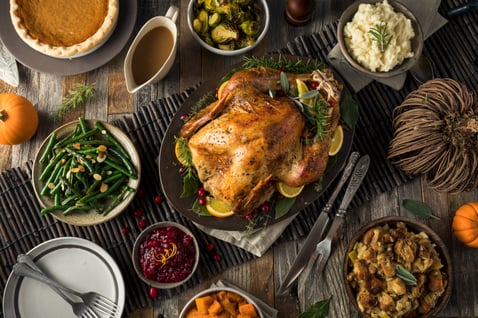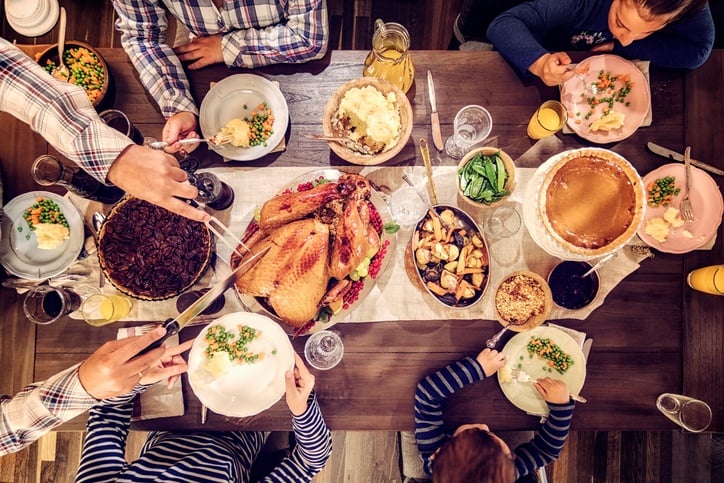 Although the holidays are meant to be a time of joy, they can be stressful for some, especially when you’re trying to lose or maintain weight, or just be more conscious of your eating habits. The best way to avoid these health-related stressors during the holidays is to prepare for them.
Although the holidays are meant to be a time of joy, they can be stressful for some, especially when you’re trying to lose or maintain weight, or just be more conscious of your eating habits. The best way to avoid these health-related stressors during the holidays is to prepare for them.
Turkey
Opt for light turkey meat over dark meat because light turkey meat tends to have fewer calories, less saturated fat, and more protein per ounce. Removing all or some of the skin prior to eating can also help reduce total caloric and fat intake.
3 ounces of light turkey meat contains:
- Without skin: 125 calories, 1.8g fat, 0.5g saturated fat, and 25.6g protein
- With skin: 150 calories, 3.8g fat, 1.1g saturated fat, and 26.3g protein
3 ounces of dark turkey meat contains:
- Without skin: 150 calories, 5.1g fat, 1.5g saturated fat, and 23.6g protein
- With skin: 175 calories, 8.5g fat, 2.5g saturated fat, and 23.2g protein
Stuffing
Replace the bagged or boxed stuffing with homemade, which is typically lower in sodium and other processed ingredients. Use whole-grain bread in place of white bread to increase fiber content.
Incorporate more vegetables (celery, onion, carrots, broccoli, corn, mushrooms) and herbs (thyme, sage) to increase the nutrient content and overall flavor of your stuffing without adding too many extra calories and salt.
Use a reduced-sodium broth in place of regular broth, which can have several hundred additional milligrams of sodium per serving.
Green Bean Casserole
Use fresh steamed green beans, rather than canned, to decrease sodium content. Or you can choose canned green beans with “no salt added.” Use reduced-sodium cream of mushroom soup and add real sautéed mushrooms for additional flavor and fiber. Try air-frying onions rather than buying packaged fried onions.
Cranberries
Use fresh cranberries in place of canned cranberries or cranberry sauce to help reduce added sugar and total caloric intake. If you must use canned cranberries, select those that are naturally sweetened without added sugars.
Potatoes
Use low-fat milk, plain Greek yogurt, or low-sodium chicken broth in place of cream, butter, or margarine. Use real potatoes with the skin intact to boost fiber content. Limit the amount of butter, salt and gravy added to mashed potatoes.
Instead of sweet-potato casserole, try roasted sweet potatoes with brown sugar, chopped nuts, and a little bit of butter available for topping.
Beverages
Limit alcohol and other calorie-containing beverages, such as soda and juice. If you do choose to consume alcohol, opt for lower-calorie drinks (seltzers, light beer, dry wines) and calorie-free mixers such as seltzer water or diet sodas. As always, be sure to consume in moderation; alcohol may make you more inclined to overeat.
Dessert
Opt for 100% pure pumpkin and reduce the amount used (or consumed) as filling to help cut back on calories. Skip the whipped cream, ice cream, and other toppings that may add additional calories.
If you’re given a choice, pumpkin pie tends to be lower in calories than pecan pie.
For many people, Thanksgiving may be the only time a year they get to enjoy pumpkin pie. If that’s the case for you, it’s perfectly acceptable to indulge; just be sure to practice portion control.
***Don’t have any say over what you and your family are having for Thanksgiving this year? Check out these tips for a practical, healthy holiday. Additionally, be sure to stay active, practice moderation and portion control, and remember: Thanksgiving happens only once a year and is much more than the food we pile onto our plates.
For more great recipes from NIFS dietitian, Lindsey Recker, go to https://www.nifs.org/healthy-recipes-nifs.
This blog was written by Lindsey Recker, MS, RD, NIFS Registered Dietitian. To learn more about the NIFS bloggers, click here.


